IMMERSED IN COLOR Sanford Wurmfeld’s E-Cyclorama
Lecture: October 27, 2011 at 7:30 PM, rm. 109 A+A bldg.
For decades, New York artist Sanford Wurmfeld has created abstract paintings about color and its affects on human mood and visual perception. In his most recent and monumental works, Wurmfeld married abstract color-field painting to the art historical tradition of 360-degree panoramic painting. Drawing inspiration from Georges Seurat, Josef Albers, Claude Monet, the Panorama Mesdag, and his previous studies of the psychological effects of color, Wurmfeld created the E-Cyclorama, an elliptical structure that houses and supports his continuous panoramic paintings. Immersed in Color at the Ewing Gallery of Art & Architecture will feature Wurmfeld’s E-Cyclorama, five large paintings of the last decade, and some of his more recent watercolor work never before shown.
The artist will give a lecture, Thursday, October 27 at 7:30pm. All events are free and open to the public. This exhibition was partially funded by the VADSCO visiting artist grant and the Visual Arts Committee. The E-Cyclorama was made possible by the Dunard Fund.
For additional information on this exhibition and to arrange a visit, please call the Ewing Gallery at 865-974-3200, or visit www.ewing-gallery.utk.edu, or Facebook.
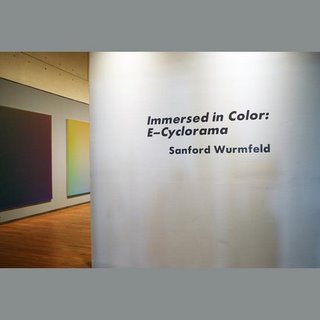
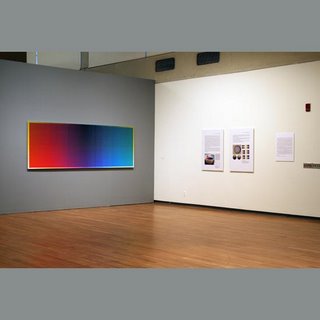
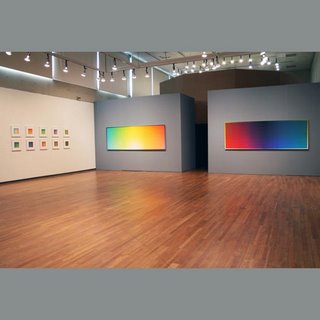
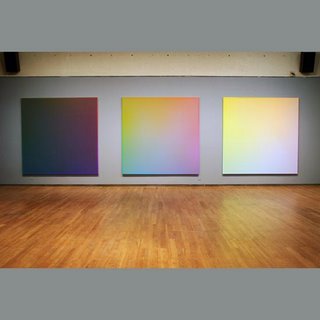
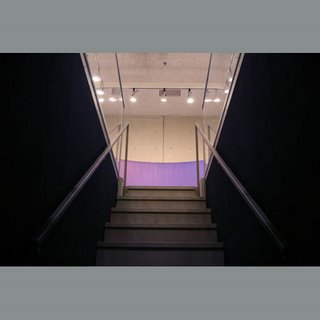
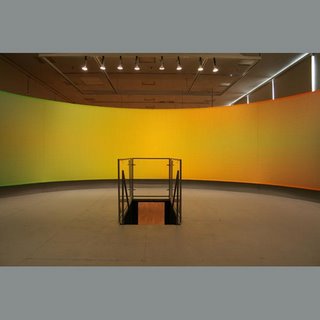
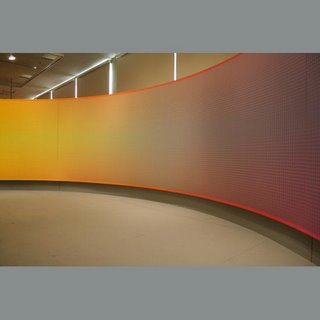
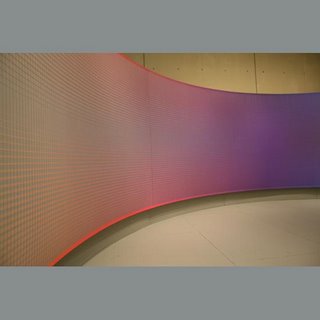

All Images: Copyright © Sanford Wurmfeld, New York
SANFORD WURMFELD November 9—December 22, 2012 Artist reception: Friday, November 16, 5:00-7:00 PM David Richard Gallery Railyard Arts District 544 South Guadalupe Street, Santa Fe, NM 87501 p 505-983-9555 | f 505-983-1284 www.DavidRichardGallery.com
David Richard Gallery is pleased to present an exhibition of paintings from 1988 to 2011 by Sanford Wurmfeld, the gallery’s first solo exhibition for the New York-based artist.
Sanford Wurmfeld’s paintings immerse the viewer in color and visual sensations. He uses the square as the basic building block, in varying sizes and shapes, in grid patterns and opposing horizontal and vertical gradients to explore the impact of spatial relationships of hues, changes in values and degree of saturation on the psychological and emotional effects of color. The culmination of the increasing complexity of his work and scale of the seminal paintings from the 1970s -some reaching 30 feet in length, engulfing the viewer and commanding even the peripheral vision- led to purchases by the Metropolitan Museum of Art, New York and Guggenheim Museum, New York for their permanent collections. In awe of panoramic paintings, his own work from the 1980s further inspired Wurmfeld to produce his first 360-degree painting, Cyclorama 2000, that truly immersed the viewer in continuous gradients and fields of color. While this exhibition will not include a Cycloramapainting, it will feature a large seminal painting from 1988 that utilized Wurmfeld’s more evolved overlapping and opposing grid system, along with many small and medium-sized works from select series that, in aggregate, produce a panoramic effect. In Wurmfeld’s newest work, painted in 2010-2011, he limits the palette and saturation of hues on a black or white ground to produce paintings that appear nearly all black or all white. The complex grid patterns and slow transitions of value provide exceptionally subtle colors that take Wurmfeld’s work to an even higher level of elegance and sophistication. But more important, the vaporous colors beg a greater engagement with the viewer to both verify the existence of color and the method of application.
Born and raised in New York, Sanford Wurmfeld studied art history at Dartmouth and taught himself to paint. Early influences were Abstract Expressionist painters Kline, Pollock, de Kooning and Rothko and then later, Monet. While traveling and living in Europe he saw the exhibition of paintings by Kenneth Noland, Frank Stella and Morris Louis at the Venice Biennale, their art influenced both his interest in and approach to studying color. In 1966 he started the MA program at Hunter College, where he studied with Ray Parker, Tony Smith, Gene Goossen and Ad Reinhardt. After becoming an adjunct faculty member of Hunter College in 1967, he formed close relationships with departmental colleagues Doug Ohlson, Vincent Longo and Robert Swain. In 1968, Goossen included Wurmfeld’s art in The Art Of The Real, 1948-68, an exhibition he curated at the Museum of Modern Art, New York and Wurmfeld had his first solo exhibition that same year at Tibor de Nagy Gallery, New York. Later, he also had solo exhibitions at the Susan Caldwell Gallery and Denise Rene Gallery. Wurmfeld was appointed Chairman of the Art Department at Hunter College in 1978, where he held that position for 28 years. He also started the Hunter Galleries and was the Director for 20 years. He has had many museum exhibitions, written extensively and contributed his essays to seminal art publications, and his work is included in many private and public international collections.
David Richard Gallery is located in the Santa Fe Railyard Arts District and specializes in post-war abstract art including Abstract Expressionism, Color Field, geometric, hard-edge, Op, Pop, Minimalism and conceptualism in a variety of media. Featuring both historic and contemporary artwork, the gallery represents many established artists who were part of important art historical movements and tendencies that occurred during the 1950s through the 1980s on both the east and west coasts. The gallery also represents artist estates, emerging artists and offers secondary market works. Gallery Hours: Tuesday through Saturday, 10 AM to 5 PM.
For additional information please contact: David Eichholtz D@DavidRichardGallery.com
Sanford Wurmfeld: Polychromy
MINUS SPACE is excited to announce the two-person exhibition Gabriele Evertz / Sanford Wurmfeld: Polychromy. The exhibition will present new works by two revolutionary New York City-based abstract color painters. Working across a wide array of media, from abstract painting to installation to filmmaking, Sanford Wurmfeld has exhaustively investigated the subject of color for more than fifty years through its essential qualities of hue, value, and saturation. In his paintings, Wurmfeld mixes and modifies colors empirically by eye without relying on any supporting scientific or mathematical system, which he then overlays onto layered grids of shifting alignment. Wurmfeld believes the perception of color to be a highly subjective experience and he openly embraces differing, individualized responses on the part of the viewer. He states, “We each bring to the paintings some kind of baggage that is far from universal, and so each of these paintings has a different emotional content. I mean emotional as an almost visceral response, rather than a feeling you would name with words. I recognize that it’s there, but I don’t think it’s something that I’m particularly controlling for the viewer. I’m just creating something that creates a kind of visceral response in me.” For further information about the exhibition and available works, please contact the gallery. Available works can also be viewed on our Artsy page: www.artsy.net/minus-space.
Sanford Wurmfeld (b. 1942 in Bronx, NY) has exhibited his work worldwide in solo and group exhibitions since the late 1960s. In 2013, he was the subject of a major 45-year survey exhibition entitled Sanford Wurmfeld: Color Visions, 1966-2013 curated by William C. Agee at Hunter College/Times Square Gallery, NYC. He has also presented solo exhibitions at Tibor de Nagy Gallery, Galerie Denise Rene, Susan Caldwell Gallery, Bard College, Maxwell Davidson Gallery (all New York), Karl Ernst Osthaus-Museum (Hagen, Germany), Mucsarnok Kunsthalle (Budapest, Hungary), Talbot-Rice Gallery (Edinburgh, Scotland), Neuberger Museum (Purchase, NY), and Ewing Museum Gallery (Knoxville, TN). In 1968, Wurmfeld was the youngest artist included in the landmark exhibition Art of the Real curated by Eugene Goossen at the Museum of Modern Art, NY. The exhibition traveled for the next two years to the Grand Palais (Paris, France), Kunsthaus (Zurich, Switzerland), and The Tate Gallery (London, England). Wurmfeld’s other museum group exhibitions include the American Academy of Arts and Letters, National Academy Museum (both New York), Dayton Art Museum (Dayton, OH), Long Beach Museum of Art (Long Beach, CA), Karl Ernst Osthaus-Museum (Hagen, Germany), and Espace de l’Art Concret (Mouans-Sartoux, France), among others. Wurmfeld has lectured and written extensively on the history of color, painting, and abstraction. He has received awards from the John Simon Guggenheim Memorial Foundation, National Endowment for the Arts, City University of New York, and Dartmouth College. Wurmfeld’s work is included in collections worldwide, including the Solomon R. Guggenheim Museum, Metropolitan Museum of Art, Brooklyn Museum (all New York), Karl Ernst Osthaus-Museum, Sprengler Museum (both Germany), and Espace de l’Art Concret (France), among others. In addition to his artistic work, Wurmfeld taught in the Department of Art at Hunter College from 1967-2012, where he educated and mentored countless generations of artists. Originally invited to join the faculty by sculptor Tony Smith and critic Eugene Goossen, Wurmfeld was Chairman of the department from 1978-2006.
